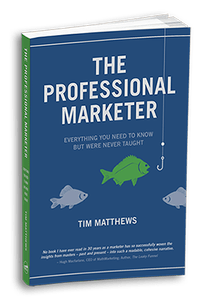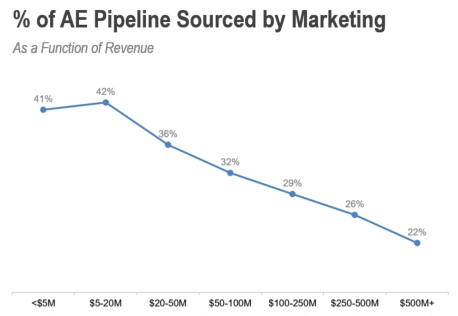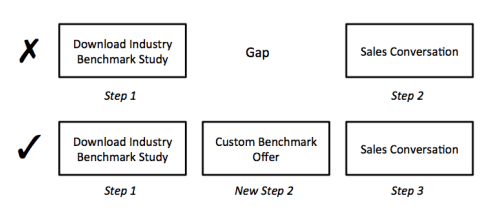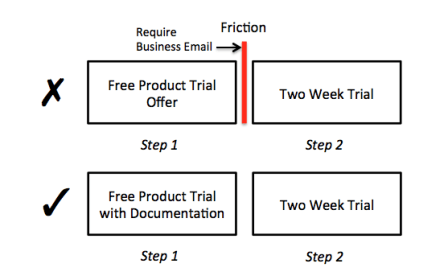Tim Matthews's Blog, page 3
March 6, 2018
When to Go Outbound, aka ‘The Inbound Trap’
Estimated Reading Time: 4 minutes
 When I ran marketing for the high-growth SaaS business Incapsula, I relied heavily on inbound marketing techniques to fuel our demand generation engine. Things went swimmingly in the beginning, but then I noticed the velocity of marketing-generated leads began to slow and dip below the growth expectations for the business. What happened? I had fallen into what I can “the inbound trap.” Let me explain.
When I ran marketing for the high-growth SaaS business Incapsula, I relied heavily on inbound marketing techniques to fuel our demand generation engine. Things went swimmingly in the beginning, but then I noticed the velocity of marketing-generated leads began to slow and dip below the growth expectations for the business. What happened? I had fallen into what I can “the inbound trap.” Let me explain.
Inbound marketing uses techniques that bring buyers to you. At its core is creating content that attracts customers. Typically, it is the combination of content marketing and search engine optimization (SEO). You write about problems or issues that are important to your buyers and related to your product, and make sure that content ranks well on Google results pages.
Outbound marketing uses conventional methods like direct mail, email, advertising, content syndication and event marketing. The easiest way to contrast inbound and outbound is to compare SEO with direct email. Search engine marketing works well because you are engaging with the buyer at the time they are looking to solve a problem. Email marketing usually starts with a database of likely buyers. You send them emails with (hopefully) attractive offers and hope they bite. Most often, however, your emails are deleted without being read.
So, what’s the inbound trap? Quite simply it is relying too heavily, or for too long, on inbound marketing. It can happen quite easily. Inbound is addictive. The leads are high quality and cheap. That’s because you are finding the buyer when they are ready to buy, and creating content of your own is less expensive than most outbound techniques.
Here was my journey at Incapsula. I broke it down into three distinct stages: $25, $50, and $100 million. Your mileage will definitely vary, but I think you can break down your growth path into three similar stages. What’s important is recognizing where you are and knowing when to add resources. And most of all, don’t fall into the inbound trap.
$25 Million
Ultimately, if you have a growth business, you will get to a point where the volume of prospects coming to you is not high enough. When that happens really depends on your company. In my experience, inbound alone won’t work when you get north of $25 million in bookings. It’s likely at this stage that you may already be utilizing Google AdWords and going to a few events. You can look at adding events, but they are the most expensive part of the marketing mix. My recommendation is to take a look at your cost per opportunity from AdWords and see if you have the budget to increase your funnel a meaningful amount (10%+) by spending more on paid advertising. NB: If you have not been spending much energy optimizing your PPC campaigns, this would be a good time to start.
$50 Million
When you get over $50 million in bookings, you really need a good balance of inbound and outbound. This is when I had that feeling that something wasn’t right. I couldn’t quite put my finger on it at the time, but I was sliding into the inbound trap. We were doing a small number of events and had a pretty well optimized AdWords campaign that I had added funding to. To counter the slide, my strategy was to go bigger with email.
A slight pause here to make an important distinction on email. Sending emails to your house list or blog subscribers is not, strictly speaking, outbound.
A slight pause here to make an important distinction on email. Sending emails to your house list or blog subscribers is not, strictly speaking, outbound. These people have already found you and may have signed up to receive your emails. It’s what Seth Godin calls “permission marketing.” Sending emails to lists you buy is outbound. That’s what I did. I called it “Project M,” which stood for “massive mailing move.” We knew our buyers very well by then – titles, problems, and what kind of assets worked. We even had predictive lead scoring in place, so there were a bunch of other signals we used to tune our lists. Too long to get into the details here, but I bought hundreds of thousands of names and started outbound emailing, with timely follow up by a sales development rep.
Also, at this stage, if it’s appropriate for your business, you probably want to start looking into how partners can help you. For many products, this means adding or growing the channel – resellers and distributors. There are a number of things you can do, from increasing recruitment, to adding rebates, or running a channel promotion (like a trip to the Super Bowl for the top channel rep). If you are an online business that relies on referrals, you may want to build an affiliate program.
$100 Million
When you get to this stage, something really painful happens. I experienced it firsthand. My sales team had gotten used to marketing delivering leads, first from inbound techniques, and then from outbound techniques. The leads had gotten harder for them to convert. Remember, inbound leads are usually ready to buy. The outbound leads were much earlier in, or not even in, the buying cycle, so they weren’t as good in the eyes of the salespeople, even if they did eventually convert.
At this later stage you need to have the conversation about sales outbound, aka cold calling or using their Rolodex. Most sales leaders know this is inevitable, but it’s never popular. It probably also means an increased investment in sales development reps.
But it’s true. Take a look at the graph below, from a study by the Bridge Group. You can see that the average amount sourced by marketing peaks in the $5 million to $20 million stage. As I said above, your mileage will vary. We peaked later and had an overall larger contribution from marketing.
Figure 1: The amount of pipeline sourced by the marketing team falls as revenue grows. Source: The Bridge Group.
One last thing to consider is cost. Depending on your average selling price, some outbound techniques may be cost prohibitive. This is where you need to understand you customer acquisition cost (CAC) and how long it takes you to make your money back, using the CAC ratio.
The cliffs I described above are from my experience. As you can see in the Bridge Group survey, the average is different from my experience, which means there are people who will have to go outbound sooner, and some later.
But whatever your case, just being aware of the inbound trap hopefully means you won’t fall in, whenever it comes.
The post When to Go Outbound, aka ‘The Inbound Trap’ appeared first on Matthews on Marketing.
February 6, 2018
Two Formulas to Measure Content Marketing
Estimated Reading Time: 2 minutes
 For all of the words written about the power of content marketing, too few discuss how it should be measured. Last year I wrote a two-part piece about what I called the economics of content marketing, in which I shared two formulas to measure its impact. The two formulas measure content consumption and profitability.
For all of the words written about the power of content marketing, too few discuss how it should be measured. Last year I wrote a two-part piece about what I called the economics of content marketing, in which I shared two formulas to measure its impact. The two formulas measure content consumption and profitability.
Consumption
Compelling people to consume – read, watch, listen to – your content is the name of the game. Here is a really simple for measuring consumption:
Consumption = Production * Distribution
The amount of consumption is the effort put into production multiplied by the amount of distribution. The better the quality of the content – the production – multiplied by a larger or more targeted channel – the distribution – the greater the consumption. You can invest heavily in creating a great piece and zero in distribution on social media and few people may find it. A tree has fallen in the woods. Likewise, a heavily promoted piece of schlock will be passed over in your reader’s Twitter feed. I think this is pretty straightforward.
Profitability
Once you get people to consume your content, you need to know it it’s making you money. Obviously, the more you spend on creating and distributing the content, the better, but is it worth it? Profitability is nothing more than an ROI calculation.
Value of Actions – Cost of Production – Cost of Distribution
____________________________________________________________
Cost of Production + Cost of Distribution
The hardest part of this calculation is putting a value on the actions your content compels.
There are six basic actions that a potential customer can take. This is how I look at measuring each action.
Action
What to Measure
Views
The number of people who see your ad or content
Shares
The number of people who share your content
Clicks
The percent of clickers who later convert via ad retargeting
Subscribes
The percent of subscribers who later fill out forms
Form fills
Your known lead conversion rate from forms
Contact sales
Your known lead conversion rate from sales contact forms
Table 1: Measuring the value of actions on content.
If you have a mature funnel have been measuring actions, you can plug in values for each. I’ve put in a few conservative percentages to flesh out our example.
Let’s assume we have a product that sells for $1000. Think of views and shares as pre-funnel, and the subsequent rows moving down the funnel. The closer we are to the bottom, the higher the conversion rate.
Action
Conversion Rate
Average
Value
Views
0.1%
$1
Shares
0.1%
$1
Clicks
1%
$10
Subscribes
5%
$50
Form fills
10%
$100
Contact sales
25%
$250
Table 2: Conversion rates and values for actions on content.
These are average values, since some leads never convert. For example, if 1 out of 100 leads converts (1%), and our sales price is $1000, the actual value of 99 of your leads is zero, but the average value of each one is $10 ($1000 * 1%). So, each click above is worth $10. You can do the math for the other actions.
Continuing our example, if each click is worth $10 to us, and we get 1500 of them, that’s $15,000 worth of actions.
Let’s say we paid a writer $2500, and a designer $1000, to create an ebook for our product. Then, we spent $1500 on Twitter promoting the ebook to our audience. Plugging in the numbers, we have our equation below:
$15,000 – ($2500 + $1000) – $1500
__________________________________
($2500 + $1000) + $1500
This reduces to
$10,000
_______ = 200%
$5000
So we have a 200 percent return on investment. Not bad.
Now you have a framework to use when planning your content marketing strategy. By understanding the cost of production and distribution, weighted against the value of specific actions, you can remove subjectivity from the process and base your investments on their profitability.
The post Two Formulas to Measure Content Marketing appeared first on Matthews on Marketing.
January 2, 2018
Hiring for Inbound, Pretargeting, Next-Step Marketing: My Most Popular Posts of 2017
Estimated Reading Time: 2 minutes
Another year of blogging in the books. I’ve covered quite a lot over these last twelve months, from hiring to demand generation to new advertising techniques. Here are the most popular.
How to Hire Great Inbound Marketers: Six Key Personality Traits
Inbound marketing requires certain skills – skills you may not have in your department. As it becomes an ever-larger part of the marketing mix, finding people who are good at inbound is going to become more important. But as buzzy as inbound marketing is, finding people who are good at it is not easy.
If you are looking to turn your existing team in to a group of inbound marketers, it may even more challenging. Years of push marketing nous does not give way easily. Most of them will have to unlearn their outbound marketing practices (assuming they were good at outbound to begin with).
Whether you are hiring a new team or evaluating your current team, you are looking for personality or character traits rather than job experience. Think of it like hiring a recent college new grad where you there is no job history to rely on, and you need to evaluate the person. Read more.
Next-Step Marketing
I’m a big fan of the buyer journey. It’s one of the most powerful marketing tools available. I’m also a big funnel geek and spend a lot of time counting leads and tweaking conversion rates.
Despite the power (not to mention the stress relief) of understanding the buyer journey, I routinely run into marketers who merely pay this concept lip service. From my experience, nonbelievers fall into two camps: those who find it too daunting and those people don’t buy into the sequential, linear path of the journey.
Because I feel so strongly about the value of the journey and wanted to find a way to convert these wayward marketers, I decided to create a simplified approach that I call “next-step marketing.” It’s a technique you can use to remove congestion in your buyer journey by focusing on a single desired next step for progressing the buyer. Read on.

Five Things I Wish I’d Include in The Professional Marketer
Surely just one minute after I hit the publish button and graduate this manuscript to a book, some new technology will emerge that promises to change the future of marketing.
That’s what I wrote in the afterword to The Professional Marketer. And while it may not have been one minute, it’s amazing what’s happened in marketing since 2014. Over half a billion people have Instagram accounts. Starting in 2016, more people accessed the web via smartphones than desktop or laptop computers. Just to name a two.
While I caution marketers not to fall in love with the latest marketing shiny object, to do the hard work, and to resist the temptation of technical shortcuts to good marketing, there are a few things I wish I would have covered in more detail in my book.
Here are my top five techniques I find myself using more frequently these days than when I was scratching out the manuscript. Read more.
Marketingspeak: What is Pretargeting?
It wasn’t too long ago that marketers were learning about retargeting. Now there’s a new sibling in the advertising family named ‘pretargeting’. So what’s the diff?
Pretargeting is an online advertising technique where marketers target individual buyers based on profile, past behavior or both. It’s pre- and not re- because your ads get shown before your targets have ever been to your website. To my mind, pretargeting is a refinement of the age old advertising demographic; it is much more personal, down to named individuals. Read more.
Did you like some of my other stuff better? Let me know. Have a great 2018!
The post Hiring for Inbound, Pretargeting, Next-Step Marketing: My Most Popular Posts of 2017 appeared first on Matthews on Marketing.
December 12, 2017
Marketingspeak: First, Second and Third Party Data
Estimated Reading Time: 1 minute
 Marketers have more data about potential customers than ever before. Some is in their own database and some is in big advertising platforms like Google AdWords. Most marketers use a combination, and hence the need to distinguish the various sources.
Marketers have more data about potential customers than ever before. Some is in their own database and some is in big advertising platforms like Google AdWords. Most marketers use a combination, and hence the need to distinguish the various sources.
First party data is the information collected by you about your prospects and customers. It is typically collected from your website or marketing automation system using cookies. It may also be supplemented by research done by your SDR team or via customer surveys.
Second party data is someone else’s first party data. When you gain access to a partner’s database to run a promotion, you are using second party data. A common example is sending invitations to a dinner you co-host with another company to their database of customers. Or maybe a vineyard wants to create a joint promotion with an artisan cheese company and advertise via retargeting from their online cheese shop. There are endless possibilities.
Third party data includes the proprietary data from Google or Bing (which you can leverage but not own), as well as data you can purchase from aggregators like eXelate, BlueKai (now Oracle) and others. If you choose to buy third party data you may also need to invest in a data management platform.
A final caution when using any kind of data. The privacy landscape is changing with regulations like CASL in Canada and GDPR for EU citizens. The ins and outs of data usage are too involved for this post, but make sure you understand how you are able to use your first, second and third party data.
The post Marketingspeak: First, Second and Third Party Data appeared first on Matthews on Marketing.
November 6, 2017
Five Things I Wish I’d Include in The Professional Marketer
Estimated Reading Time: 4 minutes
 The Professional Marketer
The Professional MarketerSurely just one minute after I hit the publish button and graduate this manuscript to a book, some new technology will emerge that promises to change the future of marketing.
That’s what I wrote in the afterword to The Professional Marketer. And while it may not have been one minute, it’s amazing what’s happened in marketing since 2014. Over half a billion people have Instagram accounts. Starting in 2016, more people accessed the web via smartphones than desktop or laptop computers. Just to name a two.
While I caution marketers not to fall in love with the latest marketing shiny object, to do the hard work, and to resist the temptation of technical shortcuts to good marketing, there are a few things I wish I would have covered in more detail in my book.
Here are my top five techniques I find myself using more frequently these days than when I was scratching out the manuscript.
SEO – I spent several pages covering search engine optimization in The Professional Marketer. My write-up is not wrong, but it is too basic. I do not discuss the whole world of off-site SEO, which are the actions you take outside of your website to improve your ranking on search engine results pages. In my opinion, on-site SEO is merely table stakes – everyone is doing it. To rank among the top three SERP results – which account for over 50% of clicks – requires links from reputable third party sites like niche blogs and trusted publications. To manage all of this work, and to ensure your site itself remains optimized, requires a lot of work – at least half a headcount and probably an agency, in my experience. If you are not using off-site SEO, you are missing a trick, and may already be at a competitive disadvantage. With the rise of mobile phone internet access, appearing in the top search results is more important than ever.
Content Marketing – I did cover the concept of content marketing pretty succinctly, and discussed various types of content, like studies and surveys, in my chapter on PR. But I’ve truly become a content marketing convert. It plays into every facet of marketing – PR, SEO, demand generation, sales enablement. I included content marketing as an emerging function in Chapter 23, “The Marketing Department.” But it’s no longer emerging – it has emerged. I think every marketing team should have a content marketing manager. This person sets the editorial calendar for the blog, works with internal and external writers, and coordinates with the demand and web teams to make sure the right content is being produced. I’ve also shifted my thinking on how to staff and fund this function. I’m now an advocate of hiring mostly external writers. They are cheap to hire, you can find specialists, and your content marketing manager – acting like an editor would – can source and manage great writers for less than you would pay to have employees who can write.
Conversion Rate Optimization – According to Chris Neuman, CEO of CROmetrics, conversion rate optimization (CRO) became a thing in 2010 with the founding of Optimizely. Their software introduced an optimization tool to the marketing world that was affordable and broadly applicable. It just wasn’t really on my radar when I was writing the book in 2012 and 2013. I started getting into it in 2016. The idea of CRO is quite simple: Once you get someone to your site or to your app, you need to make sure they convert. It’s a very important practice that can maximize your efficiency and have substantial results. One test I ran on our pricing page improved conversions by over 200%. A/B testing of email (and direct mail) has been around forever. Now that concept has been brought to the CTAs on your website. If you rely on your website to deliver leads, I would suggest you devote at least part of your web team’s energy to CRO, and invest in a software package like Optimizely to help get the job done.
Alternative PR – I still believe in press releases. They are the workhorse of PR, as I mentioned in the book. But there are so many other ways to get your news out. You can just as easily pitch a blog post to a reporter as a press release, for example. But you need to go further. At my current employer Imperva, we got a great story written by an AP reporter because he was following one of our researchers on Twitter. So make sure you make that happen; make a list of target of influential bloggers and reporters and have your spokespeople and experts – not just your PR people – follow and engage with them. There are a whole range of strategies for using social media to get your story out there. I strongly recommend David Meerman Scott’s The New Rules of Marketing and PR to get you started on a more modern approach to getting your news out there.
Advocacy – The only better salesperson than the top seller in your company is one of your happy customers. Leave a satisfied customer alone with a prospect at a cocktail party and magic will happen. Which is why I’m always surprised companies don’t spend more time cultivating customer advocates. Reference calls are one thing, but you need to really groom and reward your top customers and turn them into advocates. Giving them opportunities to share experiences and learnings at users groups is one way. I am always amazed at how much time customers will spend answering questions on forums. And of course, now we have the power of social media to connect them all. I mentioned WoM in the book, but not enough time on advocacy programs. Make sure you have a program somewhere in marketing to encourage online dialogue, reward your top advocates with swag or praise, and insider access to your CEO or head of product.
These five important practices notwithstanding, I think my book is holding up pretty well. For all the advances, the fundamentals still matter, and one could argue that these developments are really just refinements or applications of older practices. Great marketing ideas – ideas that are as relevant as ever – can be found throughout history So be inquisitive, keep learning, and beware of shortcuts.
What do you think? If you own a copy of The Professional Marketer, anything you wish I had covered?
Click here to get a preview of the book and read what people think of it.
N.B.: This article was originally published in LinkedIn.
The post Five Things I Wish I’d Include in The Professional Marketer appeared first on Matthews on Marketing.
September 12, 2017
Marketingspeak: What is Pretargeting?
Estimated Reading Time: 1 minute
 It wasn’t too long ago that marketers were learning about retargeting. Now there’s a new sibling in the advertising family named ‘pretargeting’. So what’s the diff?
It wasn’t too long ago that marketers were learning about retargeting. Now there’s a new sibling in the advertising family named ‘pretargeting’. So what’s the diff?
Pretargeting is an online advertising technique where marketers target individual buyers based on profile, past behavior or both. It’s pre- and not re- because your ads get shown before your targets have ever been to your website. To my mind, pretargeting is a refinement of the age old advertising demographic; it is much more personal, down to named individuals.
How might a marketer use pretargeting? You could place your ad in front of all people who have visited your competitor’s website. A ski manufacturer could place ads in front of those who have checked the ski report in the past month. Or you could display your ad to people with a specific title, or who work for a given company. The idea is to get in front of likely buyers even if they have never heard of you, which is of course the aim of most advertising, but this new technique is, uh, more targeted.
Pretargeting works using cookies. These cookies track all kinds of information about your online life, and combined with information about you and your profile from other sources, creates what is known as audience data. This data can then be used to create very specific audiences who can be shown ads on most major platforms – Google, Facebook, LinkedIn, Twitter and others. You can work with one of these vendors, create your own advertising data management platform, or work with a service like Terminus to target specific buyers. With so much data available, the possibilities for creating custom audiences are almost endless.
I personally am very excited about all the possible applications of pretargeting. I also love how the innovation in martech is changing the language we use – marketing neologisms spun up like never before. Seems like only yesterday I was learning what a retargeting burn pixel is. Now I find myself in strategy sessions deciding on my pretargeting vs. retargeting spend. What’s next?
The post Marketingspeak: What is Pretargeting? appeared first on Matthews on Marketing.
August 29, 2017
Next-Step Marketing
Estimated Reading Time: 6 minutes
I’m a big fan of the buyer journey. It’s one of the most powerful marketing tools available. I’m also a big funnel geek and spend a lot of time counting leads and tweaking conversion rates.
The buyer journey and the funnel are essentially the same idea – mapping the process a prospective buyer takes before becoming a customer. Understand how sales happen, and you can scale your business. Otherwise, you are merely hoping, which is not a strategy.
Despite the power (not to mention the stress relief) of understanding the buyer journey, I routinely run into marketers who merely pay this concept lip service. From my experience, nonbelievers fall into two camps: those who find it too daunting and those people don’t buy into the sequential, linear path of the journey.
Nonbelievers are usually daunted because the buyer journey can seem boundless, especially if there are multiple buyer personas who purchase multiple products. Having all those steps on the way toward a purchase is just too much to conceive of for some, and for others, too much work to create all the content.
To those who pooh-pooh linearity, I concede that many buyers purchase in a nonlinear fashion. These prospects hop all over the place, from an analyst report to your homepage, then perhaps to an ebook download, only to go to your news section and maybe only then to your key conversion form. It can be very difficult to visualize a buyer journey when prospects wander about. How can a marketer possibly plan a profitable route for buyers like these, the argument goes.
Because I feel so strongly about the value of the journey and wanted to find a way to convert these wayward marketers, I decided to create a simplified approach that I call “next-step marketing.” It’s a technique you can use to remove congestion in your buyer journey by focusing on a single desired next step for progressing the buyer.
For marketers who can’t grapple with or commit to a full buyer journey, next-step marketing greatly simplifies things. Rather than focusing on the entire journey, just focus on the next step at any given sales stage. Likewise, focusing on a single step takes the linearity argument off the table; you don’t need to think of a direct path from prospect to customer, but rather, just think of the one step to move a buyer along. Next-step marketing is really just a simple device that zooms in on one particular stage. You then simply need to ask yourself, What’s next for the prospect at that step?
The most effective way to apply next-step marketing is to start with the most crucial step in your conversion funnel. Perhaps it’s the step before a demo, or the step before somebody asks for a trial, or even the step after somebody asks for a trial. Only you will know. If you still can’t see it, look for where you are seeing blockage or congestion in your funnel, and think how might you improve that area. Zoom in on that step, and ask yourself what’s next.
Next-step marketing works because it focuses the marketing team on one situation – one problem. People find that one problem within their grasp to solve. It’s tractable. Once you have committed to next-step, you will probably find that it’s one or both of the following two issues that are causing congestion in your funnel.
Gaps
The first is a gap. A prospect takes a step on their journey, but there’s no natural next step. What usually happens next is ugly. A sales development rep (SDR) calls the prospect to talk business, and the prospect is not even close to buying. The SDR has nothing to offer, the customer wonders why the rep is overzealous, and nothing gets bought. There’s a gap because no one in sales or marketing thought about what the natural next step for a buyer should be.
It’s like that classic S. Harris cartoon where there’s a professor writing an equation on the chalkboard, and in the middle of the equation it says, “And then a miracle happens.” You can’t rely on a miracle for a sale to happen. Said another way – a little less flippantly – Why are you asking your buyer to fill in the gap when you should figure out what the next step is?
For example, if you send the buyer an industry benchmark study, perhaps the natural next step to demonstrate value is to do a customized study just for that buyer. That’s a value-add phone call an SDR could easily make. Hopefully the learnings from the customized benchmark lead to a consultative sales call. Figure 1 illustrates the before and after.
Figure 1: Adding a new step 2 fills a gap and makes for a more natural progression to a consultative sales conversation.
There are lots of potential gaps in buyer journeys. Here are a few gap fillers I’ve seen work in my career, marketing software. Say a prospect has begun a trial of your product. Having your customer success rep send them tips and tricks can help lead them down the path toward being successful with your product, and then a sales rep can reach out to talk about a purchase. If the prospective buyer can’t get the software to work properly, no way do they want to talk to a sales rep. (At best, it makes for a testy conversation.) Or perhaps a prospect downloads a top-of-the-funnel white paper. The next thing you want them to do is take a look at a market study and then move on to a customized study, as we illustrated above. Each step is more specific than the last. Importantly, each step adds value, which makes outreach easier for your SDR or sales rep.
These are only examples, of course. Only you know where the gaps are. Most of the time, marketers have not thought of what that next step is, and they leave it up to the buyer, which is a big mistake and definitely brings down your conversion rate.
Friction
Sometimes it’s not a gap that’s causing the congestion, but rather, friction. You have a next step defined, but it’s asking too much of the buyer, making them cautious and reluctant to proceed. The next step you want the buyer to take is too big. The information you’re asking for is deemed to be intrusive or inappropriate, or the amount of information is simply too much for the buyer to provide. The give is not equal to the get.
To remove the friction from your buyer journey, first you need to find it. You can either look at your conversion rates, brainstorm in a room with a group, or pretend you are a buyer and try to observe potential points of friction. Is there are reason you ask for a business email address as opposed to a personal email address? What would compel somebody to give you their business email address? Or maybe the friction point is asking for a credit card number to start a product trial? Or it could simply be that your website is confusing.
In a talk from this year’s SaaStr conference, David Skok told the story of how the middleware company JBoss “unlocked their funnel” by offering technical documentation in exchange for a business email address on their software download page. Documentation was deemed to be of real value and convinced people to give their business email (The whole talk is good, but advance to 10:45 if you just want the JBoss case study.) Figure 2 illustrates the concept, which is pretty straightforward.
Figure 2: Adding more value to the software download offer removes the friction caused by asking for a business email address.
Another common point of friction is lengthy forms, where the prospect decides it’s not worth their time to fill out a form in exchange for what you are offering. A shorter form, with more information collected during a subsequent visit, is the answer. There are all kinds of examples. If you think this way, and think what you can offer in exchange for the details you want, you can remove the friction from the process and hopefully increase your conversions.
That’s it. Next-step marketing aims to simplify the buyer journey concept by thinking of the next step to optimize conversions. It will remove stalls or friction from your funnel.
Focus in on individual stages, and pick your most problematic. Set a goal and improve the conversion rate, and once you’re finished with that, move on to your second most problematic stage, and so on. If you don’t know where to start, take a closer look at your funnel conversions and look for the trouble spots – lower than expected conversion rates or aging leads. For those who don’t have a very mature or reliable funnel, talk to your SDRs or sales reps and ask them where deals are getting stuck.
Just as every long journey starts with a single step, every great buyer journey starts with an improved next step.
The post Next-Step Marketing appeared first on Matthews on Marketing.
July 24, 2017
How to Hire Great Inbound Marketers: Six Key Personality Traits
Estimated Reading Time: 3 minutes
Note: I originally published this post on LinkedIn.
 Inbound marketing requires certain skills – skills you may not have in your department. As it becomes an ever-larger part of the marketing mix, finding people who are good at inbound is going to become more important. But as buzzy as inbound marketing is, finding people who are good at it is not easy.
Inbound marketing requires certain skills – skills you may not have in your department. As it becomes an ever-larger part of the marketing mix, finding people who are good at inbound is going to become more important. But as buzzy as inbound marketing is, finding people who are good at it is not easy.
How can that be? After all, it’s not like inbound was invented yesterday. The term ‘inbound marketing’ was coined by Hubspot’s Brian Halligan in 2005. But as recently as two years ago, only 34 percent of marketers responded that inbound was completely integrated with their marketing strategy. Unlike the more established PR or event marketing disciplines, you won’t have a talent pool with decades of experience to draw from. Typing ‘inbound marketing’ into the LinkedIn search box yielded me a little over 4,000 profiles; ‘event marketing’ yielded over 200,000. So you can’t just tell your recruiter to look for someone with inbound marketing experience and expect to have a large candidate list.
And if you are looking to turn your existing team in to a group of inbound marketers, it may even more challenging. Years of push marketing nous does not give way easily. Most of them will have to unlearn their outbound marketing practices (assuming they were good at outbound to begin with).
Whether you are hiring a new team or evaluating your current team, you are looking for personality or character traits rather than job experience. Think of it like hiring a recent college new grad where you there is no job history to rely on, and you need to evaluate the person.
Putting this into the context of a job interview, here’s how I would approach it with an inbound marketer candidate. If you have an existing team, you can assess your people against this same list and see how they rate. You might find that reassigning certain people makes sense. In either situation, these are the traits I am looking for:
Curious – Attracting buyers (total strangers really) to your blog is the first step in inbound. Who are these buyers and what do they care about? What else do they read? I’d much rather hire a marketer who is curious to find these answers than someone who happens to be an expert on my product. A good inbound marketer needs to think like a buyer and keep asking questions. I like to ask interviewees what they read and why, to tease out how innately curious they are.
Mathy – You don’t need to be a math genius to be good at inbound, but can you calculate a weighted average? Do you know that the difference between 1.5 and 2.2 is not .7, but a fifty percent improvement? I’m looking for someone comfortable with basic Microsoft Excel functions who is interested in interpreting results. In interviews I might give someone two demand channels, costs and conversion rates, and ask them what they would do to maximize spend. Just hearing how they think is informative.
Relentless – A/B testing never ends. Lead numbers keep growing every quarter. I want someone who won’t get worn down or world-weary. I like to ask inbound marketer candidates about adversity, and have them take me through a difficult life period or work situation. If the candidate happens to be an ultra marathoner, that’s a plus.
Fearless – I like marketers who are unafraid to make mistakes and fail epicly. Failing to try is trying to fail, as they say. I have had some clunker ideas myself over the years, but also some big wins (I may be the only B2B marketer to have hired two ex-FBI profilers and a WWII codebreaker to sell software). You just never know if a crazy idea is going to work. Ask the candidate what the craziest thing they ever tried was. If what you get back is timid – the kind of milquetoast response that would make you find an excuse to walk away from them at a cocktail party – then, well, you know.
Meticulous – Inbound is all about the details. Interesting, well-written content that attracts. Visually appealing offers that convert. Small tweaks to subject lines to make subscribers open them. And, of course, attention to the numbers. The resume and preparation for the interview are first indicators. If they have a portfolio, is it organized in a cool binder or cleverly on a Pinterest page? I usually give candidates who make it through the first phase some type of exercise – a presentation, a writing exercise – and I can pretty much tell.
Honest – Not every experiment will work. Good inbound marketers don’t try to spin bad results, but own up to them and try to figure out what went wrong. Far too many marketers lose credibility, in my opinion, because they are always spinning. I think that came from working in an era when the data was simply not easy to come by and people had to be self-promotional to be successful. I want clear-eyed analysis.
Inbound marketing is hard work, and every team will have stumbles along the way, even if you have a team of all stars. Having the right personality traits is a crucial first step. The last thing you want is a bunch of finger pointing know-it-alls. I really like how the late Houston Oilers coach Bum Phillips put it, “You fail all the time, but you aren’t a failure until you start blaming someone else.”
Do you know of another trait I missed? Let me know.
________
Photo courtesy of Eurico Zimbres
The post How to Hire Great Inbound Marketers: Six Key Personality Traits appeared first on Matthews on Marketing.
June 12, 2017
How to Fund a Channel Partner Program
Estimated Reading Time: 2 minutes
 Though channel partners can buy products at discounted rates, vendors still need to invest to help them generate demand. There are three basic models for funding channel partner programs: market development funds, contra-revenue funds, and co-op funds. These are distinctive models, but businesspeople commonly confuse them. Therefore, you should be careful to specify to the partner exactly what kind of funding your company offers.
Though channel partners can buy products at discounted rates, vendors still need to invest to help them generate demand. There are three basic models for funding channel partner programs: market development funds, contra-revenue funds, and co-op funds. These are distinctive models, but businesspeople commonly confuse them. Therefore, you should be careful to specify to the partner exactly what kind of funding your company offers.
Market development funds (MDF) are distributed to partners in advance of sales. Their purpose is to help develop the market or markets a channel partner serves. To receive MDF, partners are expected to submit a plan that explains how they will utilize these monies, and they must seek approval from the vendor’s channel marketing or sales team. Vendors typically employ MDF to spur growth efforts in new markets, such as new territories.
In the simplest case, companies allocate MDF funds before a channel partner achieves a steady run rate selling the company’s products. The key word is develop. To help partners establish a pipeline, a company makes MDF available for activities such as renting marketing lists, creating direct marketing materials, and running ads. The funding amount is negotiated between the vendor and partner, with the partner usually providing a simple marketing plan for the vendor to approve.
In contrast to MDF, contra-revenue (contra) funds are distributed to vendors who are already selling the company’s products at a steady clip. Partners accrue these funds as a percentage of the total revenue they generate by selling these products. The percentage is usually low single digits—typically 1 to 3 percent—and is tied to the partner program tier. In tiered partner programs, the highest-level partners receive the largest percentage of funds. This arrangement both rewards the most productive partners and incentivizes them to maintain their status. It also ensures that the vendor invests its contra funds in partners that have a proven track record and that the vendor feels confident will effectively move its products.
Even though contra funds are automatically accrued, partners need to be held accountable for how they spend these monies. When a partner wants to redeem/get paid, it submits a request for approval. To avoid frustration, the partner program should have guidelines in place for acceptable marketing activities and programs. These guidelines are entirely up to the supplier. A company might decide, for example, that purchasing tee shirts or branded tsotchkes is not something they will authorize. Contra funds also expire after a certain period, typically six months, to limit the supplier’s financial liability. CFOs don’t like unclaimed and growing liabilities on the books.
Finally, companies use co-op (cooperative) funds for shared-cost initiatives, such as advertising and direct mail. In most cases, the supplier and the channel partner split the total costs fifty-fifty. Perhaps the best known co-op program is the Intel Inside advertising co-op program, where Intel assumes some of the advertising costs for PC manufacturers. In return, the manufacturers agree to include the Intel Inside logo in their print ads and to incorporate a three-second, five-note Intel Inside tone into their television commercials. Though the distinctions can be a bit blurry, vendors usually allocate co-op funds for activities it prescribes, like including a logo in an ad. In contrast, it makes MDF funds available for activities proposed by channel partners.
This distinction notwithstanding, partners can utilize MDF, contra, and co-op funds for a variety of activities, including events, direct marketing, and promotions. They can also use these funds to purchase demo equipment, not-for-resale (NFR) software licenses, and, in some cases, necessary training that the vendor does not provide as part of the partner program.
A word of caution on all of the partner marketing fund types. Many people use the term MDF generically to mean any type of partner funding. Some confuse contra-revenue and co-op funds. Make sure you clarify in your materials and discussions to avoid potential frustration down the line.
________
The advertising results were stunning. Intel’s research indicated that only 24 percent of European PC buyers were familiar with the Intel Inside logos as of late 1991. One year later that figure had grown to nearly 80 percent, and by 1995 it had soared to 94 percent and continues at these high levels today.
The post How to Fund a Channel Partner Program appeared first on Matthews on Marketing.
May 20, 2017
Marketingspeak: Why Are PR People Called ‘Flacks’?
Estimated Reading Time: Less than a minute
Clients are never happy. Their story should have gotten more coverage. It was the agency’s fault for not pushing hard enough. The agency can’t easily tell their client that their story was a dud.
Reporters see agencies as a necessary evil. PR staffers bring them stories, but can also be pushy. And truth be told, most reporters prefer finding their own stories.
So it’s no wonder PR pros have earned the pejorative ‘flack,’ as in “Tell that PR flack to stop calling me. I’m on deadline.”
Turns out the term has nothing to do with shrapnel or criticism. No, the term comes from the “energetic” movie publicist George Flack.
He must have left quite an impression.
The post Marketingspeak: Why Are PR People Called ‘Flacks’? appeared first on Matthews on Marketing.









